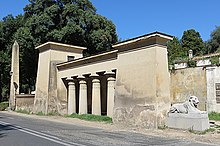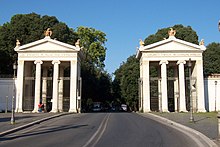Luigi Canina
Luigi Canina (born October 23, 1795 in Casale Monferrato ; died October 17, 1856 in Florence ) was an Italian classical archaeologist and architect .
Life
Luigi Canina was the son of Giacomo Camillo Canina and his wife Maddalena Robusti. He received his first school education at the Augustinian College in nearby Valenza , where he is said to have shown his first interest in architecture. In 1810 he moved to Turin and studied architecture with Ferdinando Bonsignore (1760–1843), who had been teaching at the University of Turin since 1805, and his assistant Giuseppe Talucchi (1782–1863). Interrupted by his military service in Napoleon Bonaparte's army in the years 1812-1814, he finished his studies in 1814. A scholarship brokered on Talucchi's recommendation enabled Luigi Canina to move to Rome in 1818 .
In Rome he was initially busy working on the illustrations for a new edition of the Itinerario istruttivo di Roma antica e moderna published in 1807 by Mariano Vasi (1744–1820 / 22), son of Giuseppe Vasis . The Italian archaeologist, topographer and university professor Antonio Nibby , with whom Luigi Canina came into direct contact, was responsible for this new edition .
In 1822 he presented the Accademia di San Luca with a well-received work on the Colosseum , to which he attached 15 drawings with the results of measurements and reconstructions: Anfiteatro Flavio, descritto, misurato e restaurato. The first contacts between Canina and Giuseppe Valadier must go back to this time , as Valadier was busy with excavations and restoration work in the Colosseum in the years 1819–1822. At the same time, this work shows a first turn to archaeological questions and ancient architectural history.
Borghesi architect

In 1822 Luigi Canina presented the first plans for the design of the newly acquired extensions to the park in Rome belonging to the Villa Borghese . With the support of the Marchese Evasio Gozzani , he succeeded the architects Antonio and Marco Asprucci as house architects for the Borghese family in 1825 . In 1825, commissioned by Camillo Borgheses , he designed two viaducts over the Tre Madonne road . Committed to the times, he designed one in the classicist-Egyptian style with pylons and flanking porticos and obelisks . For the design of the other building, he leaned on the models of Roman triumphal arches . Both buildings were completed in 1826/27.
The main entrance to Villa Borghese from Via Flaminia followed in 1827. With these classical Propylaea of the Ionic order , completed in 1828 and inaugurated in 1829 , Luigi Canina rose to become the most important exponent of modern Roman architecture. The building was on the same level as the comparable buildings in Hyde Park and the Munich Propylaea Leo von Klenzes .
In the 1830s, when the order situation was tight - Camillo Borghese had died in 1832 - smaller works for the Borghesi followed, which led Luigi Canina to increasingly focus on archaeological and academic topics. Nonetheless, Canina built a temple of Aesculapia in Borghesepark during this decade , monumentalized the main path of the park and designed a garden prospect with a small Corinthian temple. Restoration work kept him busy at Villa Borghese and Villa Turini on the Gianicolo . The most varied of Canina's buildings were carried out in the 1830s and 1840s on the site of the Palazzo Borghese .
In 1842 Canina accompanied Maria Christina , Queen of Sardinia-Piedmont, to Turin and a period of extensive international contacts began, which took him to England in 1845, 1851 and 1856 . In 1849 he received the Royal Gold Medal from the Royal Institute of British Architects . The trip in 1851 was a visit to the Great Exhibition , the first world exhibition . In particular, the Crystal Palace by the architect Joseph Paxton left a lasting impression on Canina, and he tried to integrate the building into his architectural-theoretical concept. In the lightness of the steel construction he saw similarities with the design methods of Pompeian wall painting . Mediated by the Egyptologist John Gardner Wilkinson he came in 1853 in contact with Algernon Percy, 4th Duke of Northumberland (1792-1865), who was on a trip to Italy. Impressed by the redesign of medieval buildings with elements of the Renaissance , he wanted to have the same implemented for Alnwick Castle in Northumberland . The Duke immediately commissioned Canina with the redesign of the interior of the castle, who, after agreeing on the drafts, implemented it in 1856, accompanied by his pupil Giovanni Montiroli (1817–1888) and assisted by the painter Alessandro Mantovani (1814–1892).
Canina's work and considerations as an architect also focused on religious architecture, including contemporary architecture. He was able to accept them if they were subject to classicist designs such as Notre-Dame-de-Lorette and St-Vincent-de-Paul in Paris or St Pancras in London. On the other hand, he rejected neo-Gothic tendencies and the associated turn to the Middle Ages . He himself was involved in the renovation and renewal of numerous churches in Rome, was also responsible for the interior design of the Gran Madre di Dio church in Turin designed by his teacher Ferdinando Bonsignore and was well advanced with his designs and models for the new building of the pilgrimage church of Oropa , when he died in Florence on October 17, 1856 after his last return from London on the way to Rome. He was buried in the local basilica of Santa Croce .
Academic and archaeologist
Due to his work as the house architect for the Borghese family, the contact with Giuseppe Valadier took a back seat. But he still had supporters in academic circles with Antonio Nibby and the Marchese Luigi Marini (1778-1838), who made his library available to Canina. In addition, Canina founded her own printing company - not only an economic success, but also a means of getting her own works to print. The printing company was one of the first to use the Italian version of Giambattista Bodoni's classicist Antiqua as its corporate font. In 1829 Canina became a member of the recently founded Instituto di corrispondenza archeologica , from which the German Archaeological Institute Rome later emerged. In 1833 he was elected a full member of the Accademia di San Luca, of which he became permanent secretary a little later. This was followed in 1834 by membership in the Pontificia Accademia Romana di Archeologia and the Accademia dei Virtuosi al Pantheon , and in 1836 by the Academy of Fine Arts Vienna .
Luigi Canina began to excavate the Borghesi estates. In 1834 he discovered the large gladiator mosaic in the Villa of Torrenova , which is now in the Galleria Borghese in Rome. He devoted extensive archaeological research to the Roman Campagna in the 1830s and 1840s . With a whole series of publications, he opened up the subject area to the interested public, in particular on the Etruscan sites, such as Caere , Veji and the central Etruscan cities such as Tarquinia .

Canina's research on Tusculum also belongs to this framework . After the death of Luigi Biondi (1776–1839), Canina took over the excavations in 1839, which are among his most important. He dedicated the results of his research in this regard - Descrizione dell'antico Tuscolo - published in 1841 to his patron Maria Christina, Queen of Sardinia-Piedmont. The philosophy faculty of the University of Tübingen awarded him an honorary doctorate for this work in the same year . From 1848 to 1850 he undertook excavations on the Esquiline and uncovered the frescoes with the Odyssey landscapes. In 1849 he found the famous Roman replica of Apoxyomenos des Lysipp in Trastevere and at the same time began excavations in the Roman Forum in the area of the Basilica Iulia . He also began extensive excavations on the Via Appia between the tomb of Caecilia Metella and Bovillae , which he carried out until 1853. In 1855 he became director of the Capitoline Museums in succession to Marchese Giuseppe Melchiorri (1796–1855). Under Pope Pius IX. and during the brief period of the Roman Republic of 1849, Luigi Canina was an elected member of the city council in 1847, 1849 and 1854. In 1855 he was promoted to the nobility of the city of Rome.
Publications (selection)
- Architettura dei principali popoli antichi considerata nei monumenti. 9 volumes. Rome 1827-1844.
- Le nuove colors della Villa Borghese denominata Pinciana. Società Tipografica, Rome 1828.
- Pianta topografica di Roma antica con i principali monumenti ideati nel loro primitivo stato secondo le ultime scoperte, e con i frammenti della marmorea pianta capitolina disposti nel suo dintorno. Canina, Rome 1830 (2nd edition 1850; digitized version ).
- Indicazione topografica di Roma antica. Canina, Rome 1831 ( digitized version ).
- Descrizione storica del Foro Romano e sue adiacenze. Canina, Rome 1834 ( digitized version ).
- Descrizione di Cere antica. Canina, Rome 1838 ( digitized version ).
- Esposizione storica della Campagna romana antica. Canina, Rome 1839.
- Descrizione dell'antico Tuscolo. Canina, Rome 1841 ( digitized version ).
- Pianta della Campagna romana. Canina, Rome 1843.
- Ricerche sull'architettura più propria dei tempi cristiani, ed application della medesima ad una idea di sostituzione della Chiesa cattedrale di S. Giovanni in Torino. Canina, Rome 1843 (considerably expanded new edition 1846).
- L'antica Etruria marittima compressa nella dizione pontificia descritta ed illustrata con i monumenti. 2 text and 2 plate volumes. Canina, Rome 1846-1851 ( digitized version ).
- Gli edificj antichi dei contorni di Roma cogniti per alcune reliquie. 6 volumes. Bertinelli, Rome 1846-1856.
- L'antica città di Veij descritta e dimostrata con i monumenti. Canina, Rome 1847 ( digitized version ).
- La prima parte della Via Appia dalla Porta Capena a Boville. Two volumes. Bertinelli, Rome 1853 ( Volume 1 , Volume 2 ).
literature
- Oreste Raggi: Della vita e delle opere di Luigi Canina, architetto ed archeologo da Casal-Monferrato. Discorso, Casale Monferrato 1857.
- Geoffredo Bendinelli: Luigi Canina (1795-1856). Le opere ei tempi con documenti inediti (= Rivista di Storia Arte Archeologia per le Provincie di Alessandria e Asti. Volume 62). Società di storia, arte e archeologia, Alessandria 1953.
- Werner Oechslin : Canina, Luigi. In: Alberto M. Ghisalberti (Ed.): Dizionario Biografico degli Italiani (DBI). Volume 18: Canella – Cappello. Istituto della Enciclopedia Italiana, Rome 1975.
Remarks
- ^ Luigi Canina: Scavi dell'Agro romano. In: Bullettino dell'Instituto di corrispondenza archeologica. 1834, pp. 193-196 ( digitized version ); see the gladiator mosaic Galleria Borghese at amphi-theatrum.de of the State Archeology Department Mainz.
- ^ Morgenblatt for educated readers . 23rd year, 1842, p. 27.
- ↑ For the frescoes see Ralf Biering: Die Odysseefresken vom Esquilin. Biering & Brinkmann, Munich 1995.
| personal data | |
|---|---|
| SURNAME | Canina, Luigi |
| BRIEF DESCRIPTION | Italian classical archaeologist and architect |
| DATE OF BIRTH | October 23, 1795 |
| PLACE OF BIRTH | Casale Monferrato |
| DATE OF DEATH | October 17, 1856 |
| Place of death | Florence |


